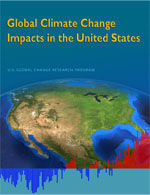ASHEVILLE N.C. — Do you believe summers are hotter here than they were years ago?
Do you notice more homes at the shore with air conditioners than a decade or two ago?
It’s not your imagination, according to Tom Peterson, chief scientist for NOAA’s National Climatic Data Center.
“We’re getting a dramatic taste of the kind of weather we are on course to bequeath to our children and grandchildren,” he said. “That’s one of the things that we’re really quite confident in, that the summers will continue to get warmer not only in New Jersey but in most of the United States.”
Peterson said it was one of the strongest signals of climate change in the climate models “and they all agree on that.” He said that doesn’t mean in 50 years all of the weather will be the same as a heat wave now but heat waves like we have recently experienced will become more common.
“As the average temperature increases, the warmer than average temperatures will get warmer and the colder than average temperatures will get warmer,” said Peterson.
“The beach season in Cape May may start earlier and may be less appealing in the really hot part of summer but have a longer season in the fall,” he said.
Heavy precipitation is also increasing. Weather models are predicting strong low-pressure events that can produce blizzards, which will also increase as a result of climate, change but they may tend to move a little farther north, he said.
The World Meteorological Association announced that 2000 to 2009 was the warmest decade on record.
NASA projected 2010 will be the warmest year on record. The past 12 months have been the hottest consecutive months on record, according to NASA.
Is there a tipping point when it is too late to prevent the negative affects of global warming? Peterson said the U.S. Global Change Research Program report on the United States clearly shows the projections for the year 2100 vary considerably the amount of carbon dioxide that is estimated to be in the atmosphere.
Peterson said while we can change the course we are on, there is already enough carbon dioxide in the atmosphere that will cause continued warming in the next decade.
“If something suddenly wiped out all humans off the face of the earth, we will still see continued warming for awhile based on the changes that are already in place in the atmosphere,” he said. “How they are longer term depends on what we do now and what we do in the next 10 to 15 years.”
In the report on global warming impacts to the U.S., using the highest emissions scenarios with business as usual with no regulation of greenhouse gases or breakthroughs in solar energy, the temperature and precipitation in southern Minnesota was projected to be, by the end of the century, would be similar to the current climate in northern Oklahoma in summer.
The Regional Climate Impact from global warming for our region predicts more days above 90 degrees, more precipitation and a longer growing season. Over the next several decades, temperatures in the Northeast, which includes New Jersey, are projected to rise an additional 2.5 to 4°F in winter and 1.5 to 3.5°F in summer.
Cities that today experience a few days above 100°F each summer would average 20 such days per summer while certain cities such as Philadelphia would average nearly 30 days over 100°F.
“In addition to the physiological stresses associated with hotter days and nights, for cities that now experience ozone pollution problems, the number of days that fail to meet federal air quality standards is projected to increase with rising temperatures if there are no additional controls on ozone-causing pollutants,” said the report.
“The dairy industry is the most important agricultural sector in this region, with annual production worth $3.6 billion. Heat stress in dairy cows depresses both milk production and birth rates for periods of weeks to months. By late this century, all but the northern parts of Maine, New Hampshire, New York, and Vermont are projected to suffer declines in July milk production under the higher emissions scenario.
In parts of Connecticut, Massachusetts, New Jersey, New York, and Pennsylvania, a large decline in milk production, up to 20 percent or greater, is projected,” according to the report.
The report was approved by its lead USGCRP Agency, the National Oceanic and Atmospheric Administration and the Committee on the Environment and Natural Resources on behalf of the National Science and Technology Council.
The report is available at: www.globalchange.gov/usimpacts
Cape May – Governor Murphy says he doesn't know anything about the drones and doesn't know what they are doing but he does know that they are not dangerous. Does anyone feel better now?








